1997 CHEVROLET S10 key
[x] Cancel search: keyPage 64 of 402
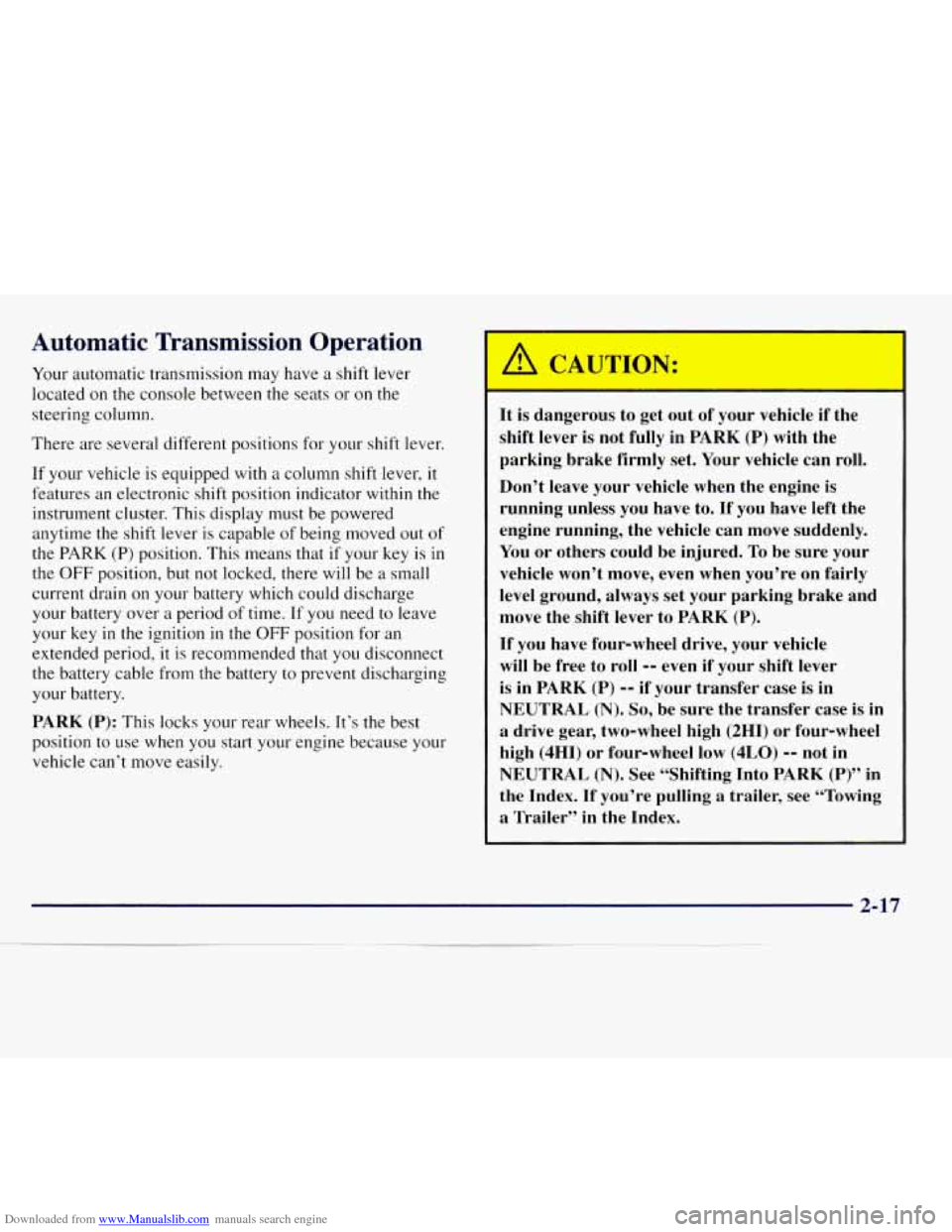
Downloaded from www.Manualslib.com manuals search engine Automatic Transmission Operation
Your automatic transmission may have a shift lever
located
on the console between the seats or on the
steering column.
There are several different positions for your shift lever.
If your vehicle is equipped with a column shift lever,
it
features an electronic shift position indicator within the
instrument cluster. This display must be powered
anytime the shift lever is capable of being moved out
of
the PARK (P) position. This means that if your key is in
the
OFF position, but not locked, there will be a small
current drain
on your battery which could discharge
your battery over a period of time.
If you need to leave
your key in the ignition
in the OFF position for an
extended period, it is recommended that you disconnect
the battery cable from the battery
to prevent discharging
your battery.
PARK (P): This locks your rear wheels. It’s the best
position to use when you start your engine because your
vehicle can’t move easily.
Lf! C A TION:
It is dangerous to get out of your vehicle if the
shift lever is not fully in
PARK (P) with the
parking brake
firmly set. Your vehicle can roll.
Don’t leave your vehicle when the engine is
running unless you have to.
If you have left the
engine running, the vehicle can move suddenly.
You or others could be injured.
To be sure your
vehicle won’t move, even when you’re on fairly
level ground, always set your parking brake and
move the shift lever to
PARK (P).
If you have four-wheel drive, your vehicle
will be free to roll
-- even if your shift lever
is in
PARK (P) -- if your transfer case is in
NEUTRAL (N). So, be sure the transfer case is in
a drive gear, two-wheel high (2HI) or four-wheel
high (4HI) or four-wheel low (4LO)
-- not in
NEUTRAL (N). See “Shifting Into PARK (P)” in
the Index.
If you’re pulling a trailer, see “Towing
a Trailer’’ in the Index.
2-17
Page 77 of 402

Downloaded from www.Manualslib.com manuals search engine Move the lever rjp as far as it will ga:
.3. If you have four-wheel drive with a manual .transfer
case shiftleverj be sure the transfer case is in a drive.
gear
-- not in NEUTRAL (N).
4. Turn the ignition key to LO-CK.
5. Remove the key and take it with you. Fyou c.an
remove the key from your ignitibn, your vehicle is in
PARK (P),
Console Shift Lever
1. Hold the bvake pedal dawn with your ri,ght foot and
2. Move the -shift .lever into PARK (PI position like this:
set the ,parking brake.
0 Hold in the button on the lever.
0 Push the lever abbe way towd the front of
t-he. vehicle.
3. Turn the ignition key to LOCK.
4. Remove the key and take it with you. If y0.u can leave
your vehicle
with the key, your vehicle is in PARK (P).
2-30
Page 79 of 402
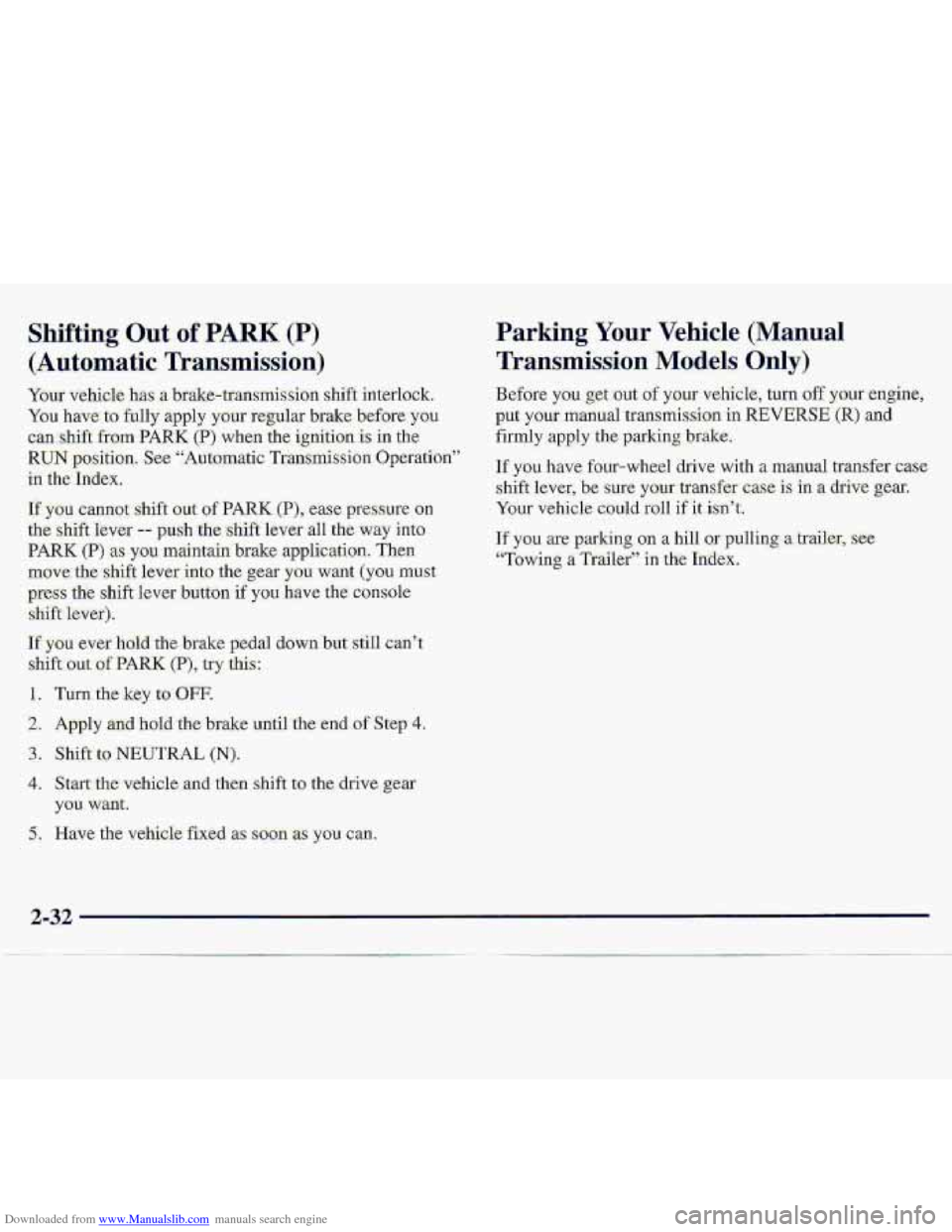
Downloaded from www.Manualslib.com manuals search engine Shifting Out of PARK (.P)
(Automatic Transmission)
Your vehick has a brake-transmission shift biterlock.
You have to fully apply your regular brake before. you
can :.shift from PARK (P) when the i-gnitlon is in the
RUN position. See- “Automatic Transmission Operation”
in the Index,
If you cannot shift out of PARK (P), ease pressure on
the shift lever -- push the shift lever all the way into
PARK (PI as you maintain brake application. Then
move the shift lever into the gear you want (you must
pms the shift lever button if you have the. console
shift lever).
If you ever ho1.d the brake pedal down but still can’t
shift out
of PARK- (P), try this:
Par g, Your Vehicle (M-anual
Transmi,ssion Models Only)
Before you-get out of your vehicle, turn off your engine,
put
y.0~11- manual transmission in REVERSE-(R) and
firmly .apply the parking bzakei
If you have four-wheel drive with a manual transfer case
.shift lever, be sure
your transfer case is in a drive gear.
Your vehic1.e
could roll if it i.sn’t.
If you are parking on a hill or pulling a trailer, see
“Towing a Trailer” in the Index.
I. Turn the key to OFF.
2. Apply and ho-18 the brake until the end of Step 4.
3. Sliiffto NEUTRAL (N).
4. Start. the vehicle and then shift to the drive gear
5. Have the vehide fixed as soon as you can.
you want.
2-32
Page 103 of 402

Downloaded from www.Manualslib.com manuals search engine Air Bag. Readiness-L-ight
There is '.an air hag readines.s light on the instrumen-t
panel, which shows A1R.BA.G. The syste.m checks the.
air.
bag's electrical system for malfunction-s. The light
,tells
.you, if thereis -an ekctrical pmbkm. The system
check
ificlndes .the ak bag sensors, the ,air bag. nzQdule,
the wiring. and the diagnostic module. For- more
infcjrmation on the air bag system, s,ee "Air Bag" in
the
Index.
AIR
BAG
'This, light will come on
when you start your engine,
and it will flash for a few
-seconds. Then the light
:should go Out.. This means
,the system is r"eady.
If-tbe air bag readiness light stays on afterylau start the
efi.gine or c.omes on wh&n you are drivingj. yo.ur air bag
s.ystem may not work properly. Have :your vehicle
serviced right away.
The air bag readiness light sho.uid. flash.for a few
seconds when you turn the. ignition key to RUN. If the
light doesn't come
on. then, have it- fixed SO it will be
ready to warn you if there is a problem.
I--i/
The charging system light
will c.ome on briefly when
you turn on the ignition,
but the engine is not
-running, as- ,a cheek to
show -you it is- working.
1t:should go .out once the engine. is Iuming. If it stays
on, or corms on while you are driving; you may have a
problem with the chargigg system. It c'ould. indicate that
you have problems with a generator ,dsive belt, or
%math& ekctrical probIern. Have it checked right away.
Driving whilethis light is. on could drain ,your b.attery.
If you must drive a short distance. with the light an, be,
certain
to turn. off all your wxssories, .such as the radio
adair conditioner.
Page 105 of 402
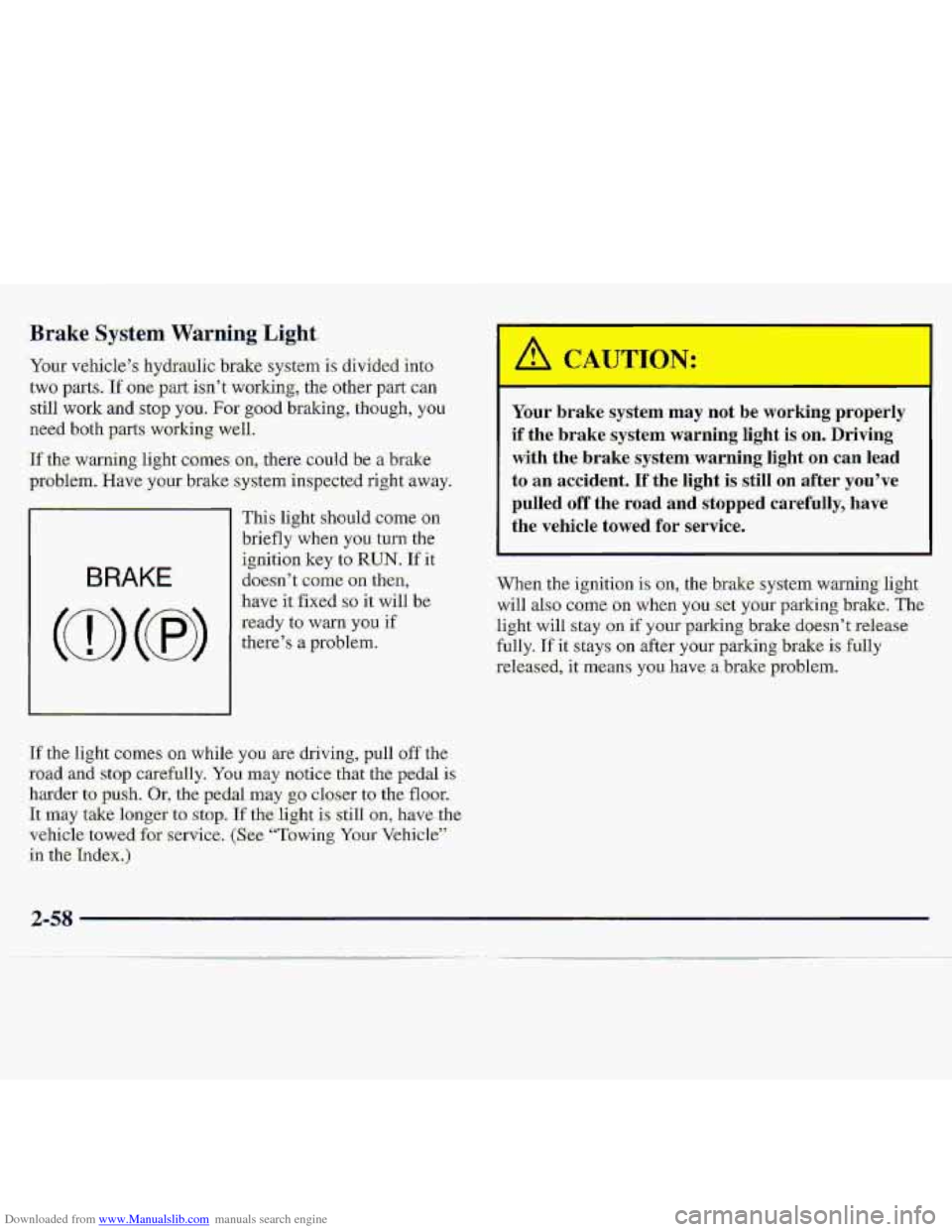
Downloaded from www.Manualslib.com manuals search engine .Brake System WarningLlght
‘Your v&iiele”s hydraulic brake system is divided into-
.two pam. If one part i.sn’t working, thc other part. can
-still work and stop you. For go.od haking, though, you
need both parts working well.
‘If the warning. light comes- an, thae could be a brake
problem. Have ymr brake system inspected right -away.
BRAKE
I
This li.ght shouId came on
briefly when you turn the
ignition key
to RUN. If it
do-e-sn’
t come on then,
have it fixed so it will be
ready to warn you if
t11ei3e7.s 8 problem..
If the light camcs .gn while you are- driving, pull off the
road aid stop carefully. You may notice ,that the pedal is
.harder-t=o push. Or, the pedal may $0 closer to the floor.
‘kmay ‘take ionger to. stop. If the-light is sail1 on, have the-
vehicle
tawed for service, (S:ee- “Towing Your Vehicle”’.
in the
Index.)
J:
Your brake sysrem may not be working properly
if
the brake system warning light is on. Driving
with the brake system warning light on can lead
to an accident. If the light is still on after you’ve
pulled off the road and stopped carefully, have
the vehicle
towed for service.
.When the ignition is on, the brakesystem warning light
will also c0rn.e oa when yo.u.:set y.@ur parking brake. The
light will stay .on if your parking brake doesn’t release
fully.
If it stays on after your parking brake is fully
-released,
it means you have a brake problem.
2-58
Page 140 of 402
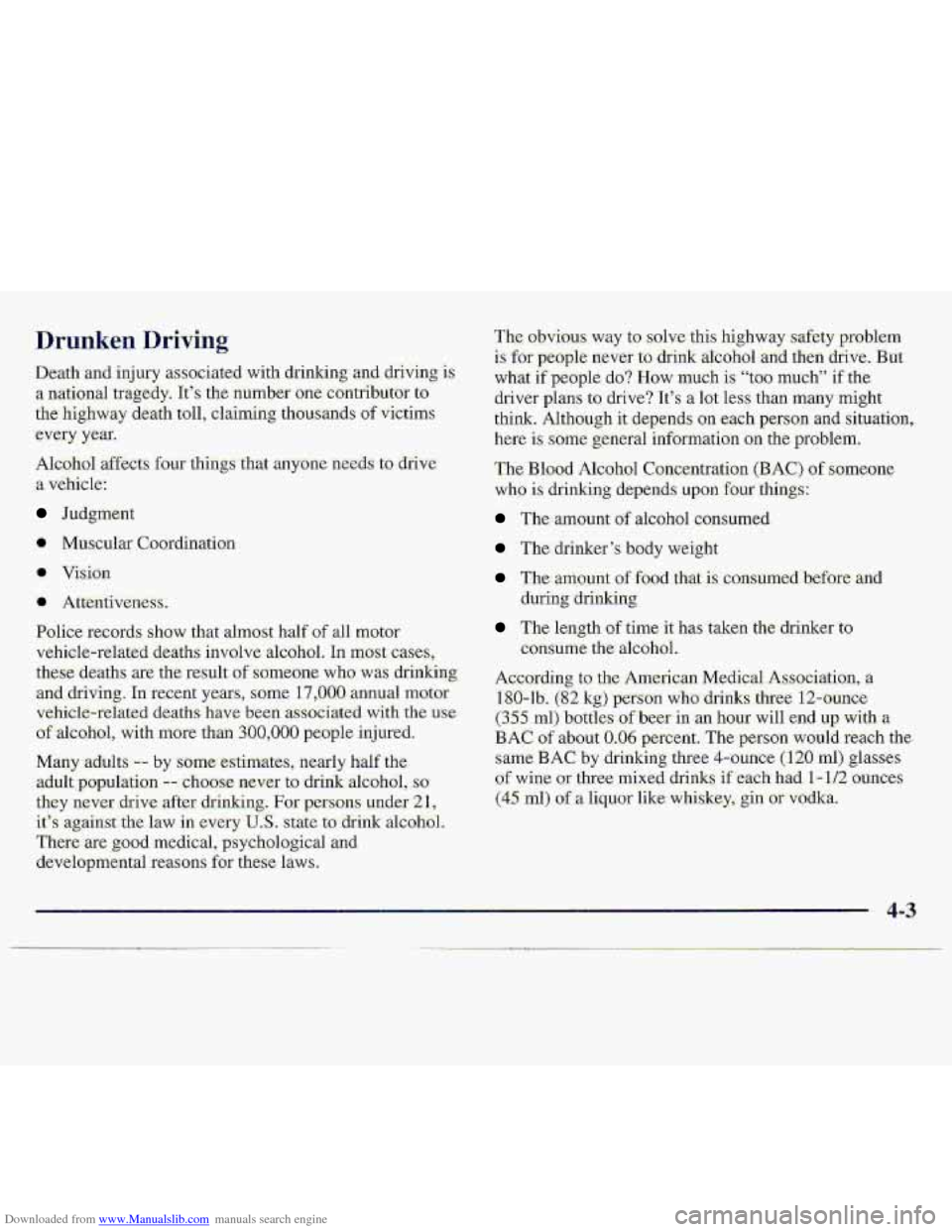
Downloaded from www.Manualslib.com manuals search engine Drunken Driving
Death and injury asscxiated with drinking md driving is
a nati0n.a.l .tragedy. 11's the. riumber one c6ntjribLttor tQ
the h.ighway de.ath toll, claiming thomands of victims
.every year.
Judgment
m Muscular Coordination
. vision
The BLo.o,d Alcohc\l Cowentratiorr (BAC) of someone
who is drinking depends upon four things:
The'amount of alcohol .consume,d
The.drinker 's- body weight
The-:mount of fo:od that is con~urnedlhefo.re a1
The length of time it has taken the drinber'to
durin-g
-drinking
consumE the-
alcohol.
Ac.cording
tq the, AniGrican Medical. As:Sso.c.iati~n, a
18U-lb. (-8.2 kg) person wha drinks three. 12-ounce
(3.55 ml) bottles, uf.beer in an -hour will, end up with.-&
BAC :of ab0u.t 0.06 perc.ent.-The person would reach the
same BAC by drinking three &ounce (~120 rnl) glasses
of wine or three mixed drinks if :ex& had. 1- 1/2 ~unces
(45 ml) -.of.& liquor like. whiskey, .gin a~ vodka
4-3
Page 180 of 402
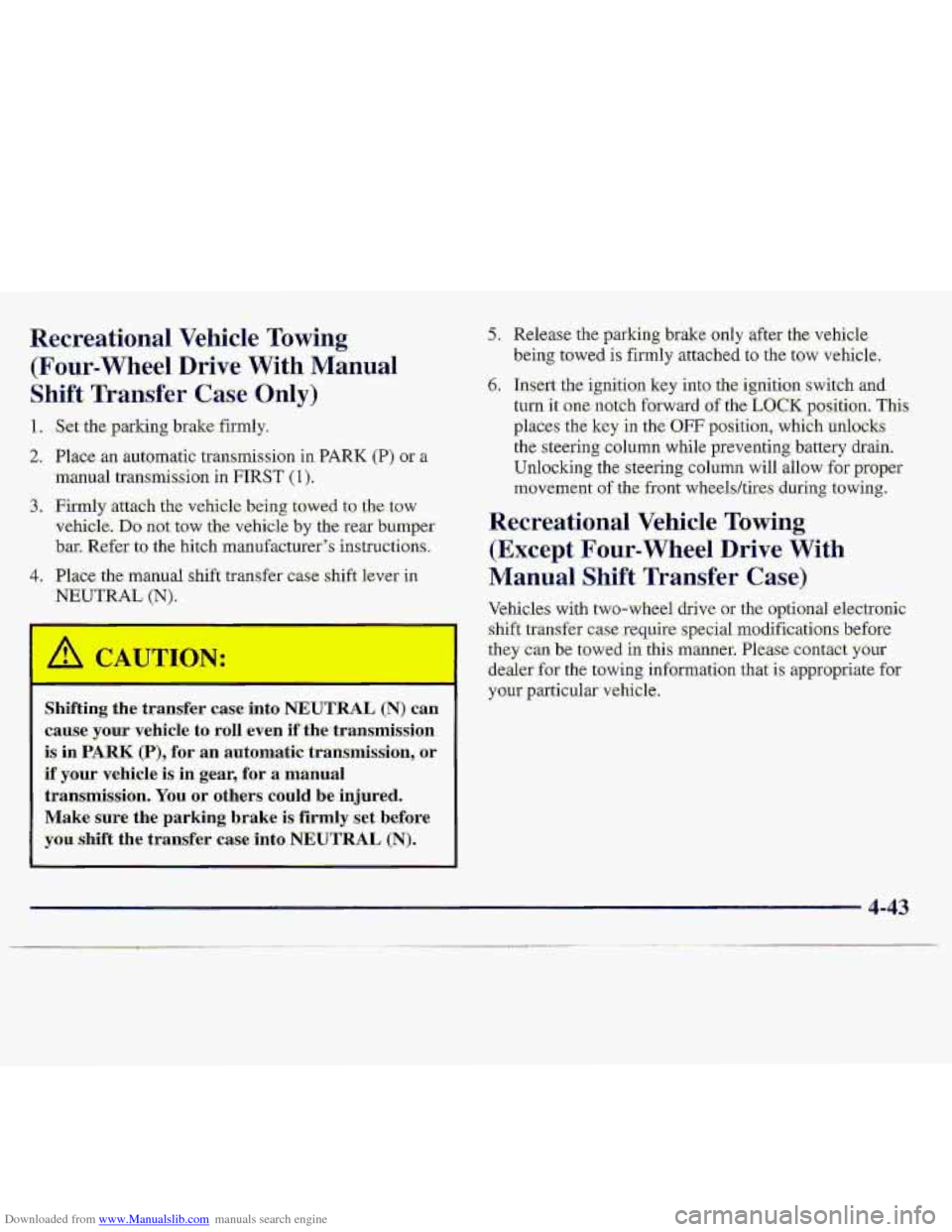
Downloaded from www.Manualslib.com manuals search engine Recreational Vehicle Towing
(Four-wheel Drive With Manual
Shift Transfer Case Only)
1 * Set the 1 'king brake: firmly.
2. Place an auromatic transmission in PARR (P) qr a
-manual transmis'siori in FIRST (1).
3. Firmly attach the vehicle .being towed to the 'to,w
vehick. Do not tow the. v&icle by the rear bumper
bar. Refer to the hitch manufactu.rer's instructions.
4. Place the manual shift transfer case- shift lever in
'NEUTRAL (N).
Shifting the transfer case into NEUTRAL (N. an
cause your vehicle
to roll evenif the transmission
is in PARK (P), for an automatic transmission, or
if your vehicle is in gear, for a manual
transmissi6n.
You or othets could be injured.
Make sure the-parking brake is firmly .set befbre
you shift the transfer case into NEUTRAL (N).
5. Release the parking brake only after the -vehicle,
being
towed is firmly attache-d to the tow vehicie.
6; Ins-ert thei-gnitiaa key into the ignitim switch md
turn it one notch fixward of the LOCK position. This
places the key in the OFF po'sitiofi; which 'ufilocks
the steering column while preventing battexy draia.
Unlocking the
steering column will allow for proper
rnovemcnt of the:front w'beel.s/tirr;s during towing.
R-ecre.ationa1 Vehicle Towing
(Except Four-Wheel Drive With
Manual Shift Transfer Case)
4-43
Page 199 of 402
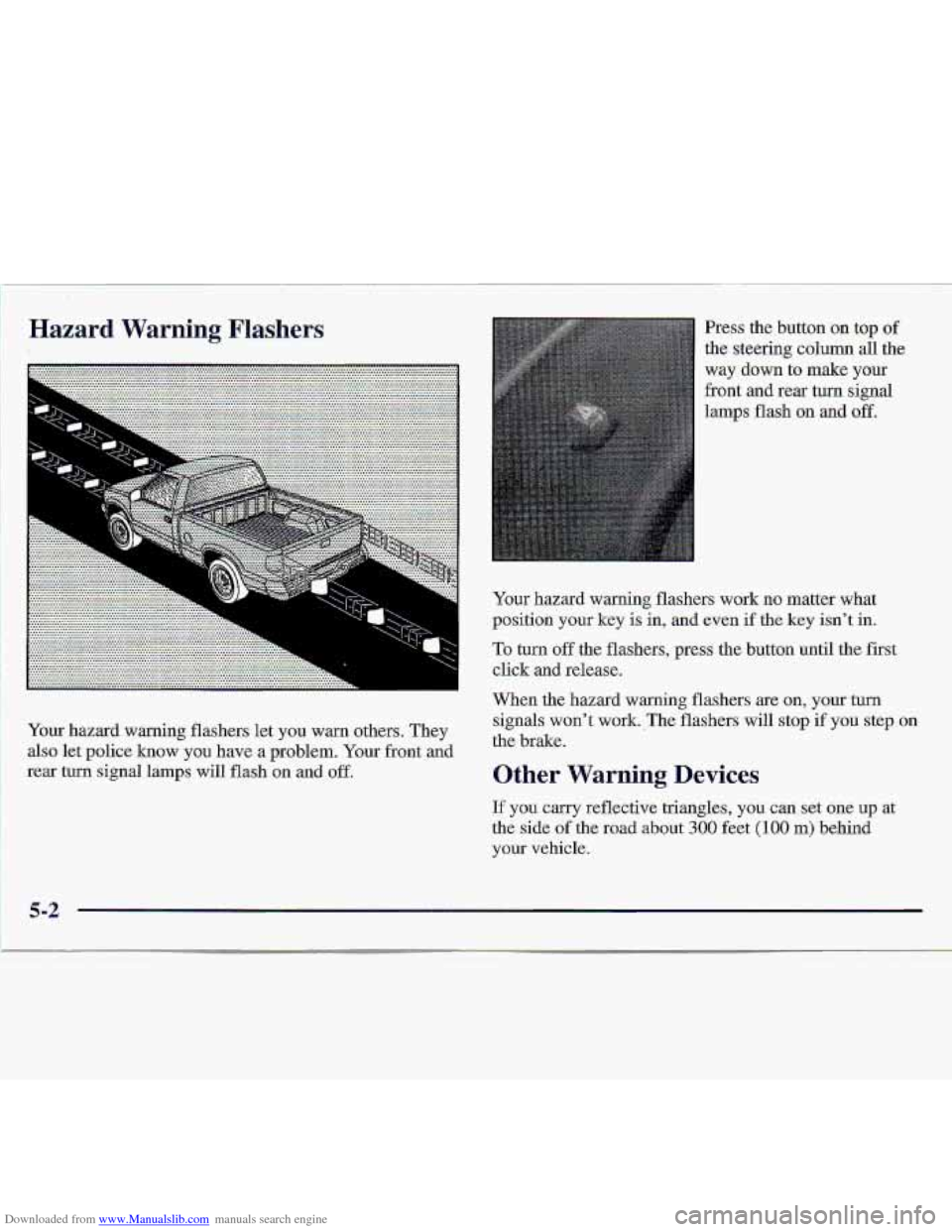
Downloaded from www.Manualslib.com manuals search engine Hazard Warning Flashe-rs
,, n.....,.,. . _. . . . , . . . . . . ... ..
Yom hazard warning flashers let you wan others. They
also kt police how you have. a-pmblem. Your front and
rear turn signal lamp$ will flash on and off.
Press the button on -top -or
the steering column all the
wgy down to make your
front and rear turn signal
lamps. flash :on ad off.
Your hazard warnirrg flashers work no matter-what
position your key is in, and even if the key isn't in.
To turn off the flashers, pres the-button until the first
click. and release..
When
the hazard warning flashers are on, your turn
signals won't work. ,The flashers -will stop if you step on
the brake.
Other Warning Devices
If yb~ &ry Pkflective triangles, .you can set one up at
the side of the road about 300 feet (100 m) behind
your vehicle.